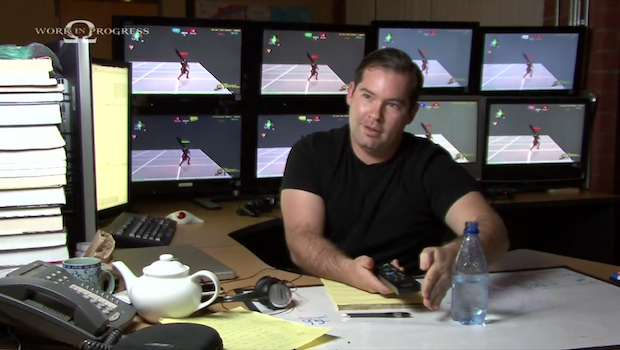12 steps to a video game release
A 'how-to' for launching like a champ

Game marketing 101
It isn't easy, but that's why they hired me, the go-to guy for planning a game release. There's a routine we have to stick to, and it begins with making sure the media only knows what you're working on when we're good and ready to spill the beans. The first step? Getting it to look like they're the ones running the show...

Step 1: Plug the Leak
Here's the good news: leaks are PR gold. You can wait for a source to scoop you on your own announcement, or you can drop a few leaks of your own and watch the frenzy begin. For example, you know that team working on Hitman's Oath: Egyptian Pride? I got one of the leads to wear a pyramid hat to E3. And those boys working on Murder Sim VI? I had their promotions team "hide" it in an email and accidentally copy some media snitches. Trust me, all it takes is a little tease and you'll have everyone with a keyboard frothing at the mouth. Just make sure you act surprised and deny it when the press comes knocking. We don't want to commit ourselves to anything this early in the game.

Step 2: Announce it (but not really)
Careful; this part can get tricky. The idea is to keep the rumor mill churning without saying or doing anything official. You don't want to blow the big reveal, but you don't want those gamez journos to stop talking about you. So if you're doing interviews, give 'em vague answers like, Let's just say fans will fall out of their seats four what we're working on. Or We cannot confirm The Elder Scrolls VI: DragonDong is in production. You guys got a blog? Post something about how you're excited to announce a top-secret project you can't talk about along with a blurry pic of the main character's helmet. Ultimately, the goal is to keep fans hungry and guessing until the interns in marketing are ready to make this thing official.

Step 3: Nail the reveal
As for nailing the reveal, you know the drill. Drag one of your celebrity buddies or an athlete on stage, load 'em up with marketing jargon, and let the live streams roll. Don't let them talk too long (they might explode), just get them prattling on about the "next generation of [insert genre here]" before introducing the one thing everyone got out of bed to see...

Step 4: Be a tease
What's that? You don't have enough actual game to show off yet? Pas de problem, mon ami. Slap together a few screenshots, record some epic-sounding narration, and wrap it up with a few seconds of gameplay we're not even sure we'll use in the end. Hell, if you're feeling ambitious, invest in a slick CGI film that has little or nothing to do with the final product (it worked for those Dead Island guys, and folks are still getting misty-eyed about that zombie girl). The takeaway here is the teaser trailer is just that: a tease. It doesn't have to have anything to do with the final product, just enough of something to get people talking until those promo guys can throw together something more concrete.

Step 5: Start a diary
Now, developer diaries are an extra expense, but hot damn do gamers love 'behind-the-scenes' action. Pimp out your designers to talk about Creating the New Post-Apocalypse or some nonsense, or grab some chump from multiplayer to chat about The Evolution of Squad-Based Tomfoolery. Above all, make it interesting and make it look like you're the first studio to do something everyone else has been doing for decades. Remember: it's not called racing, it's Drive-sanity, and it's going to change world.

Step 6: Destroy the demo
Honestly, I'd rather skip the public showing, but if we absolutely need to have a demo, consider holding a "behind closed doors" event to make it feel special... like they should be honored to play something they've been promoting for free. You can even try playing the game for your guests, but those entitled brats will probably want to give it a go themselves. Whatever. Let 'em go nuts. Just make sure you're always a foot away and talking in their ear so they're distracted from the fact that Drive-sanity isn't the huge revolution we promised. As for the walking ATMs--er, gamers--we'll put out a demo with all the best bits later on, but that's when we're ready to sell and need those guys tweeting up a storm. Hmm. Now that I think about it, we should really bundle your demo with one of our upcoming releases... make those suckers work for it.

Step 7: Spin the delay
The trick to delays is the spin. You don't want to be quoted saying, we never took that date seriously. Instead, it should appear as though the game is so brain-meltingly good that you just realized it's going to need more time to cook. Talk about how you've decided to add extra features or how you're committed to making this the best Resident Zombie game ever. If they really hound you for another date, choose a generic period like fall 2014 or Holidays 2015. Technically, a year is full of holidays, so you won't be lying.

Step 8: Pimp the pre-orders
Unfortunately, gamers aren't cool with laying down cash without something in return. We need to pony up some "pre-order" incentives like toys they'll eventually sell in a garage sale or exclusive in-game content we can turn round and jam into our Game of the Year edition. That new Outfall: Atlantic City game they're working on down the hall? They're giving away a free Deathclaw toothbrush. And those guys working on the next Artifact Hunter sequel? They're handing out a free see-thru bikini skin. Which reminds me: if you do go for in-game content, make sure you hold on to it. We're going to want to re-release it as DLC in about six months.

Step 9: The sweet release
article about midnight releases
Our job doesn't stop on launch day though. You'll need to do pull together any sales stats you can dig up, add in the copies we've "shipped", round it up, and pimp, pimp, pimp! Our research shows gamers will only buy a game if others are buying it too. We need to get the message out that this release is balls-to-the-walls successful, and anyone who isn't in line at this very moment will be a social outcast by week's end.

Step 10: Pest control
What you do here is really your choice. If you do decide to fix it (again, run it by sales), release a stealth update when no one is looking, or cram it in a larger update to make it look like it was no big deal. And if it's really bad, toss in some free in-game money. Nothing smooths over ill-will towards an unfinished game like free content for that very same game.

Step 11: Milk the microtransactions / DLC
Here's where you can get creative. For starters, multiplayer games are microtransaction hotspots. Gamers like feeling like special little snowflakes, and they don't like working for in-game rewards like their parents did in the 1980s (got I feel old). Give 'em special colors for their weapons and let them buy their way up the online food chain. If you're making a solo game, put out something cool like a flaming sword or a silly costume. Screw it, let's get R&D in here and install debit machines in every consoles so they can just buy their way to the end of the game. After all, today it's all about collecting trophies, comparing e-peens, and make believe ranks. If you think about it, we're really doing them a favor.

Step 12: Do it all again
...and then start it all again. These trendy offices aren't going to pay for themselves, you know. We're 364 days away from the sequel and the guys in sales need something to leak.
If you want more on making games, be sure to check out how to make a video game with no experience and how to get into PC gaming.
Matt Bradford wrote news and features here at GamesRadar+ until 2016. Since then he's gone on to work with the Guinness World Records, acting as writer and researcher for the annual Gamer's Edition series of books, and has worked as an editor, technical writer, and voice actor. Matt is now a freelance journalist and editor, generating copy across a multitude of industries.


